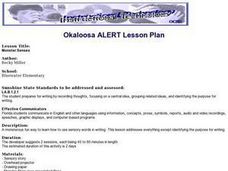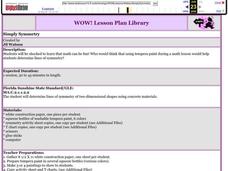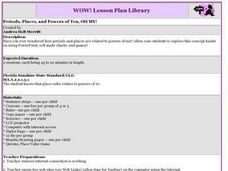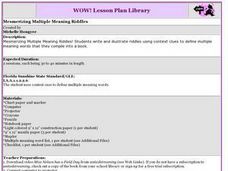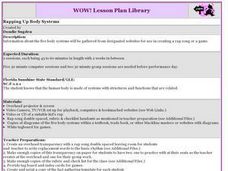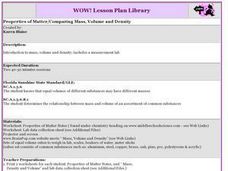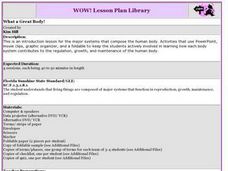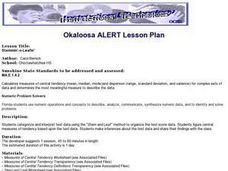Curated OER
Machines: Not So Simple
Students examine the names and images of simple machines in a matching activity. They build a simple machine using K'NEX before taking and printing out a digital picture of their example. They complete five station activities based on...
Curated OER
Genes, not Jeans
Fifth graders examine the difference between dominant and recessive genes, and what happens when genes are combined. They complete a worksheet on genetics after observing if they can wiggle their ears or roll their tongues. They...
Curated OER
Greater Gator Takes a Chomp
Second graders discuss alligators before making an alligator out of paper plates. They use the mouth of the paper plate alligator to show greater than, less than, or equal to while the teacher models different sets of hornets on the over...
Curated OER
Monster Senses
Second graders listen to a story that contains many sensory words to describe an object. They listen a second time using a signal to indicate when they hear a sensory word. They write a short story about a monster using appropriate...
Curated OER
Rockin' Rock Cycle
Students label a diagram of the rock cycle with correct labeling and writings in science log. They define 3 types of rocks: igneous, sedimentary, and metamorphic and label the stages of the rock cycle and explain the process.
Curated OER
What's the Matter?
Learners use knowledge of the states of matter while creating an informational book on solids, liquids, and gases. They watch a class video about matter and then discuss what they know about the three types.
Curated OER
It's Cool to Know the Rule in School!
Students work with partners taking turns using the teacher-made input/output boxes. Two students will be the tellers, while the other two are the customers. The tellers stand behind the box, and know the rule. When the customers put in...
Curated OER
Conservation Connection
Students work in groups to create a script for a one minute commercial on how to conserve our reusable energy sources. When the scripts are written, explain to the students that a story board is similar to a cartoon.
Curated OER
Simply Symmetry
Students make pictures with squeeze bottles of tempera paint, and fold the paper to show lines of symmetry. They complete a T chart to showing lines of symmetry. They access a website to complete a symmetry activity.
Curated OER
Understanding Place Value
Student examine the place value of digits in number up to 1000. They participate in a modeled lesson about identifying place values. They access a math program online to practice this skill and complete worksheets.
Curated OER
Probability Polly
Students evaluate if an event is certain, probable, or impossible. They design and create a spinner to be used in a game which demonstrates the possible outcome of an event.
Curated OER
Write From the Beginning
Students discuss the earliest form of writing, pictographs and view several examples. They then create their own hieroglyphics and write a short story using them. They then create and label a timeline including methods of writing prior...
Curated OER
Graph It!
Students create a graph with a title, labels, scales and intervals independently. They then take the opportunity to evaluate graphs created by classmates using a peer evaluation sheet.
Curated OER
Plant It!
Students watch a video on the parts of plants and their uses. They then observe a live plant and on a worksheet label the four main parts of the flower (flower, leaves, rooms, and stem).
Curated OER
Periods, Places, and Powers of Ten, OH MY!
Students label a chart that includes place value periods (units, thousands,
millions, billions), places, and examples of each place value in powers of ten. They then show knowledge of how place value relates to power of ten by reading 8...
Curated OER
Mesmerizing Multiple Meaning Riddles
Students write and illustrate riddles using context clues to define multiple meaning words that they compile into a book. They read the book, Miss Nelson Has a Field Day, and observe the many different multiple meaning words...
Curated OER
Rapping Up Body Systems
Learners review handouts explaining that within the next 2 weeks the students are to visit the designated websites to gather information on the 5 body systems. This information is used to create a rap song which will be video taped or a...
Curated OER
Get In Line!
Young scholars compare and order fractions and decimals using a number line. They use rules of conversion to determine equivalencies competing problems accurately and plot points on the number line that represent the correct order of the...
Curated OER
Tumbling Cubes
Students compare fractions and decimals while playing a game and order fractions and decimals found on the number cubes to create a number line. They then play a game called the Fraction Decimal Toss.
Curated OER
Properties of Matter/Comparing Mass, Volume and Density
Students participate in a discussion of volume and density and then engage in a hands on lab. They weigh equal volume cubes at lab stations of an assortment of common substances in a lab setting and record data on their findings on...
Curated OER
Cells Brochure
Students examine the structure and functions of an animal or plant cell. They view an online video about cells, conduct Internet research on the Brain Pop website, and create an informational brochure about cell structure and functions.
Curated OER
What a Great Body!
Students use PowerPoint, movie clips, graphic organizers, and a foldable to research and display information about how each body system contributes to the regulation, growth, and maintenance of the human body. Additional links and...
Curated OER
Conserve and Recycle: I Do My Part!
Students focus on ways that they can recycle and conserve resources. They watch a web-based video at a subscription website before designing PowerPoint presentation that shows three ways to conserve and recycle in their lives. They...
Curated OER
Stemmin'-n-Leafin'
Students make stem and leaf charts to determine the measures of central tendency using test score data. They analyze the data to draw inferences which they share with the class. They complete the associated worksheets.



